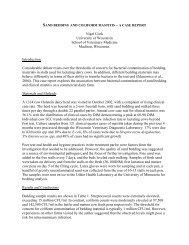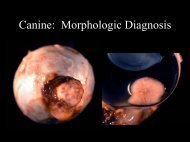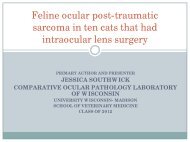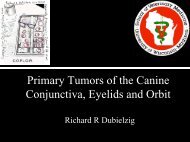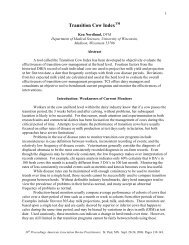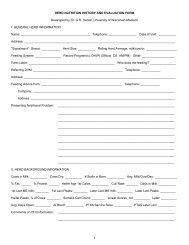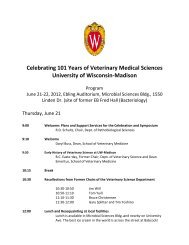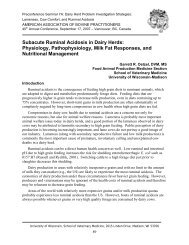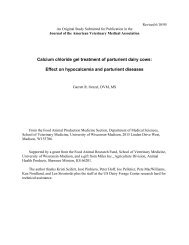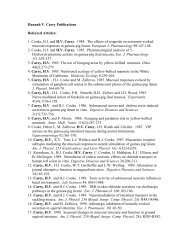On Call Fall / Winter 2011 - School of Veterinary Medicine ...
On Call Fall / Winter 2011 - School of Veterinary Medicine ...
On Call Fall / Winter 2011 - School of Veterinary Medicine ...
You also want an ePaper? Increase the reach of your titles
YUMPU automatically turns print PDFs into web optimized ePapers that Google loves.
Peter Muir recognized<br />
for work in canine<br />
research<br />
dr. Peter<br />
Muir, a small<br />
animal<br />
orthopaedic<br />
surgeon at the<br />
University <strong>of</strong><br />
Wisconsin<br />
<strong>School</strong> <strong>of</strong><br />
<strong>Veterinary</strong><br />
<strong>Medicine</strong>, was<br />
honored at the American <strong>Veterinary</strong><br />
Medical Association’s (AVMA)<br />
Annual Convention in St. Louis,<br />
Missouri where he received the<br />
AVMF/AKC Career Achievement in<br />
Canine Research Award, celebrating<br />
his long-term contributions to the<br />
field <strong>of</strong> canine research.<br />
The award ceremony recognized<br />
Muir along with some <strong>of</strong> the nation’s<br />
top veterinarians, celebrating<br />
outstanding performance in their<br />
specialties and their devotion to<br />
improving the lives <strong>of</strong> humans and<br />
animals.<br />
Muir’s skill in orthopaedics and<br />
his advances in canine research are<br />
recognized world-wide. His focuses<br />
include stress fractures in racing<br />
greyhounds, tendon and ligament<br />
diseases, and degenerative cranial<br />
cruciate rupture in dogs. At the UW<br />
<strong>School</strong> <strong>of</strong> <strong>Veterinary</strong> <strong>Medicine</strong>, Muir<br />
is co-director <strong>of</strong> the Comparative<br />
Orthopaedic Research Laboratory, a<br />
multi-disciplinary effort directed at<br />
solving orthopaedic problems that<br />
plague both humans and animals.<br />
He has also served in leadership<br />
roles for the American College <strong>of</strong><br />
<strong>Veterinary</strong> Surgeons Credentials<br />
Committee, the Journal Advisory<br />
Board for <strong>Veterinary</strong> Surgery, and<br />
the AVMA Council on Research.<br />
The AVMF/AKC Career Achievement<br />
in Canine Research Award was<br />
established in 2009 by the American<br />
Kennel Club (AKC) and the American<br />
<strong>Veterinary</strong> Medical Foundation<br />
(AVMF).<br />
8<br />
Dog overboard!<br />
Charlie’s leg was broken in four large pieces with many smaller fragments. The surgeons<br />
at UW <strong>Veterinary</strong> Care used an external method <strong>of</strong> securing the fractures.<br />
For most dogs, jumping from<br />
a boat into the water means<br />
good clean doggie paddling<br />
fun. Unfortunately a three-year-old<br />
boxer named Charlie, chose the<br />
worst time to fall overboard: while<br />
the boat was still moving.<br />
Charlie hit the propeller blade,<br />
and when her owners pulled her<br />
from the water, she was bleeding<br />
heavily from cuts on her leg.<br />
Rushed to a nearby emergency<br />
clinic in Spooner, Wisconsin, her<br />
prognosis was grim.<br />
Charlie’s leg was badly broken<br />
in several places. “I asked if they<br />
could set her leg, and they said<br />
‘No,’” said Tom Lewandowski,<br />
Charlie’s owner. Afraid <strong>of</strong> losing<br />
Charlie’s leg or worse,<br />
Lewandowski sought other options.<br />
“I talked to three different<br />
vets, and they all said to take her<br />
right to Madison.” So that’s<br />
exactly what they did.<br />
<strong>On</strong>ce at UW <strong>Veterinary</strong> Care,<br />
Charlie passed into the hands <strong>of</strong><br />
Dr. Jason Bleedorn, a small animal<br />
surgeon who had different ideas<br />
about Charlie’s outlook. The situation<br />
looked bad; Charlie had large<br />
cuts exposing open fractures, and<br />
her leg was broken into four pieces,<br />
with many smaller fragments.<br />
Bleedorn knew that plates and<br />
screws would not work for this<br />
kind <strong>of</strong> injury. “You’re not going to<br />
be able to rebuild that fracture like<br />
a carpenter,” Bleedorn said.<br />
Instead, he devised an alternative<br />
approach that combined x-ray<br />
guided surgery and an external<br />
method <strong>of</strong> securing the fractures.<br />
Using fluoroscopy, an imaging<br />
technique that obtains real-time<br />
moving images <strong>of</strong> the internal<br />
structure, Bleedorn tracked the<br />
different bone pieces and monitored<br />
the wound during surgery.<br />
“You can use the fluoroscopy to<br />
guide you,” said Bleedorn. “It was<br />
a perfect opportunity to use this<br />
technology.”<br />
With fluoroscopy, Bleedorn<br />
placed eight pins in Charlie’s leg,<br />
but probably not in the way you<br />
would imagine. Pins protruded<br />
out from the different segments<br />
<strong>of</strong> bone, and were then fixed to<br />
a device outside Charlie’s body.<br />
This device, called an external<br />
skeletal fixator, consisted <strong>of</strong> a ring<br />
around Charlie’s thigh and a titanium<br />
rod running down her leg,<br />
providing her with stability so her<br />
bones could heal. The device had<br />
the added bonus <strong>of</strong> eliminating a<br />
bulky cast. For Charlie, this was<br />
a must, because her cuts from the<br />
propeller blade required easy access<br />
for frequent attention.<br />
Bleedorn said the one downfall<br />
<strong>of</strong> the external fixator is the maintenance.<br />
“It takes a lot <strong>of</strong> aftercare<br />
by the owners,” said Bleedorn.<br />
“But these owners were great.”<br />
(Top) Charlie’s leg before<br />
surgery. (Middle) Surgeons<br />
use fluoroscopy to help<br />
guide surgery during the operation.<br />
(Bottom) Charlie’s<br />
leg with the external fixator.<br />
Charlie is healing, with the help<br />
<strong>of</strong> the Lewandowskis’ care. “My<br />
wife has to clean the pins <strong>of</strong> the<br />
apparatus,” said Lewandowski.<br />
“It’s a three times a day situation.”<br />
But Charlie is getting back to her<br />
old self. “She can’t do the things<br />
she wants to do, but her energy<br />
level is more back to normal,” said<br />
Lewandowski.<br />
Dr. Bleedorn is hopeful that<br />
given more time, Charlie will be<br />
able to lose the external fixator altogether,<br />
transitioning to a smaller<br />
brace before finally having all four<br />
paws back on the ground.<br />
Ali Bartol



